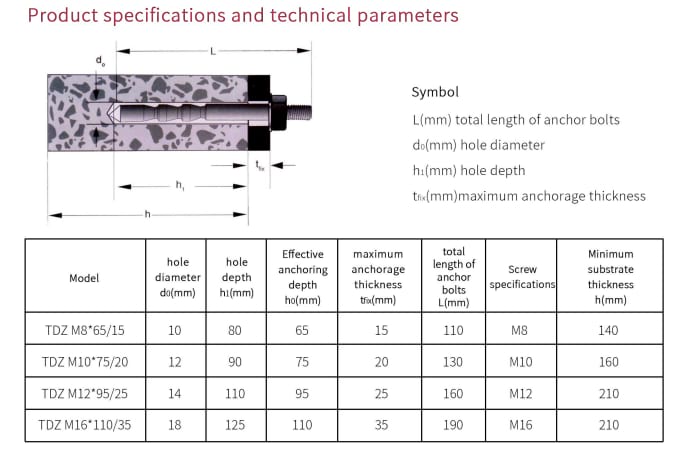

| Availability: | |
|---|---|
| Quantity: | |











Advantage
High Load - Bearing Capacity: Through the dual effects of chemical bonding and mechanical locking, the inverted - cone - shaped chemical anchor bolts can withstand large tensile and shear forces. They can meet the requirements of projects with high anchoring strength, such as heavy - duty mechanical equipment, bridges, high - rise buildings, etc.
Good Corrosion Resistance: The material is usually carbon steel above grade 5.8 or 304/316 stainless steel. The surface of some products is also treated with anti - corrosion measures such as galvanizing, which can effectively resist the erosion of the external environment and extend the service life.
Excellent Seismic Performance: Under dynamic loads such as earthquakes, the inverted - cone design and high - strength bonding of the inverted - cone - shaped chemical anchor bolts can ensure that the connection between them and the concrete substrate will not be easily damaged, providing reliable anchoring support for the structure. It is suitable for applications such as seismic brackets and equipment fixation.
Convenient Construction: The installation process is relatively simple, mainly including steps such as drilling, hole cleaning, glue injection, and screwing in the anchor bolts. It does not require complex construction equipment and techniques, which can effectively shorten the construction period.
Application
In subway and high-speed rail systems, the anchor secures critical components such as catenary supports and pantograph arms, ensuring stability during high-speed train operations. It is also used for anchoring tunnel joint-sealing cover plates and emergency escape platforms, where vibration resistance is essential.
In high-rise buildings and bridges, it fixes steel structural elements (beams, columns) to concrete foundations, reinforcing overall structural stability. It is also widely used in concrete renovation projects, such as anchoring new components or repairing structural cracks in aging buildings.
For commercial and high-rise building skylights, the anchor secures frames and connecting parts, withstanding wind loads and temperature-induced expansion/contraction. Its corrosion resistance ensures durability even in exposed rooftop environments.
Advantage
High Load - Bearing Capacity: Through the dual effects of chemical bonding and mechanical locking, the inverted - cone - shaped chemical anchor bolts can withstand large tensile and shear forces. They can meet the requirements of projects with high anchoring strength, such as heavy - duty mechanical equipment, bridges, high - rise buildings, etc.
Good Corrosion Resistance: The material is usually carbon steel above grade 5.8 or 304/316 stainless steel. The surface of some products is also treated with anti - corrosion measures such as galvanizing, which can effectively resist the erosion of the external environment and extend the service life.
Excellent Seismic Performance: Under dynamic loads such as earthquakes, the inverted - cone design and high - strength bonding of the inverted - cone - shaped chemical anchor bolts can ensure that the connection between them and the concrete substrate will not be easily damaged, providing reliable anchoring support for the structure. It is suitable for applications such as seismic brackets and equipment fixation.
Convenient Construction: The installation process is relatively simple, mainly including steps such as drilling, hole cleaning, glue injection, and screwing in the anchor bolts. It does not require complex construction equipment and techniques, which can effectively shorten the construction period.
Application
In subway and high-speed rail systems, the anchor secures critical components such as catenary supports and pantograph arms, ensuring stability during high-speed train operations. It is also used for anchoring tunnel joint-sealing cover plates and emergency escape platforms, where vibration resistance is essential.
In high-rise buildings and bridges, it fixes steel structural elements (beams, columns) to concrete foundations, reinforcing overall structural stability. It is also widely used in concrete renovation projects, such as anchoring new components or repairing structural cracks in aging buildings.
For commercial and high-rise building skylights, the anchor secures frames and connecting parts, withstanding wind loads and temperature-induced expansion/contraction. Its corrosion resistance ensures durability even in exposed rooftop environments.

